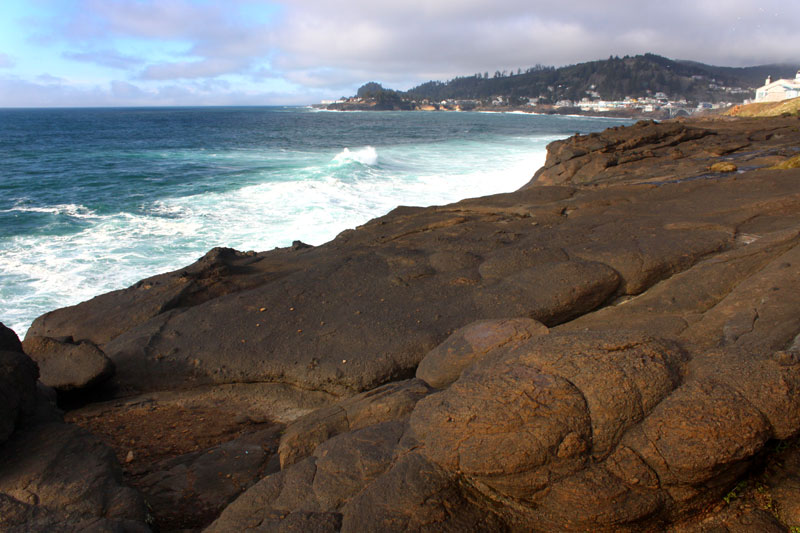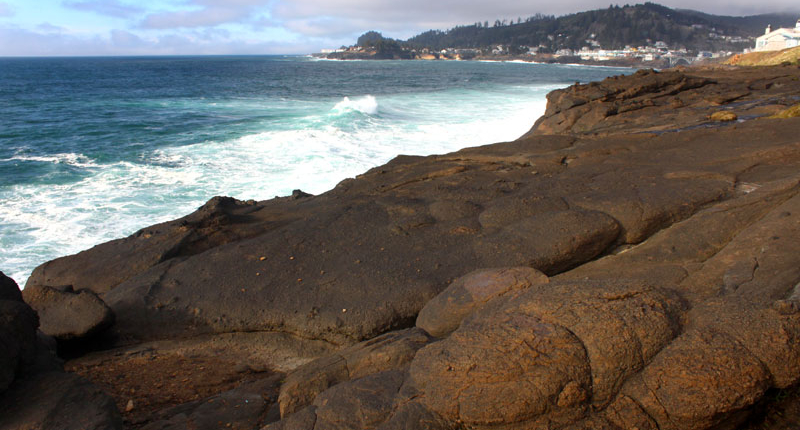Depoe Bay is a food haven for gray whales because of the abundant mycid shrimp living in the kelp forests. These whales become residents of the area, and their young acquire a “fondness” for the place, instilled by the mother. Jump-Off Joe is a popular attraction in Newport that was a giant blob of rock that broke in half, eventually dissipating, with only remnants left. The soft, sandstone cliffs of Newport’s Nye Beach that make up Jump-Off Joe and other areas did not take well to the change in currents when the jetties were built in the 1890s. The residents of Newport and Depoe Bay can visit local hotels, dine at various restaurants, and experience the beauty of the area through virtual tours and maps.

The Oregon coast has a lot of untold stories that are ancient and possibly spooky. Depoe Bay and Newport are sister and brother in a funky, geologic way, with their own plot twists. The two places have some interesting features, including the resident whales, crazed lava flows, and dead landmarks.
Yaquina Head and Cape Foulweather were thought to be volcanoes at one point, but this theory was debunked in the ’70s. They are both the result of the Columbia Basalts, a series of lava flows that crossed proto-Oregon about 14 million years ago from Eastern Oregon. The shoreline was 40 miles east then, and these areas were underwater. The lava flows filled up massive underwater canyons and were eventually eroded over millions of years, turning into their current shape. Other places like Tillamook Head and Neahkahnie Mountain were also the same.
Depoe Bay is mostly basalt, but what makes it smoother than other similar areas? Dr. Scott Burns, a geology professor at Portland State University, explains that the area around Depoe Bay was above ground, which is why when lava flows arrived, they would hit the sea and cool into rounder shapes. These are called pillow basalt, which is the same thing seen in Hawaii when lava plunges into the water. These pillow basalts run from Fishing Rock State Recreation Area down to Rocky Creek State Scenic Viewpoint, about four miles on either side of Depoe Bay, and can be hundreds of meters thick.
There is more than one Jump-Off Joe in Newport. The original Jump-Off Joe was a famous rock structure on Nye Beach that was destroyed in the 1920s. There is now a park named after it. Another Jump-Off Joe is a rock formation on Agate Beach, which is also a popular spot for surfers.
In conclusion, Depoe Bay and Newport have some interesting geological features, including ancient lava flows, pillow basalts, and unique landmarks. These fascinating facts make these areas worth visiting and exploring.
Jump-Off Joe, the famed rock structure at Newport’s Nye Beach, was once a popular attraction in the early 1900s. It was a soft, sandstone cliff that broke in half, leaving a giant blob at the tideline. The blob, known as Jump-Off Joe, had an arch that tourists loved until it fell apart in 1916. The rest of the structure was gone by the 1930s. Locals loved Jump-Off Joe so much they named another headland south of it as Jump-Off Joe, which also acquired an arch and became a huge hit. However, in the ’90s, that arch fell, and the rest of the headland whittled away until it became unstable in early 2022.
Depoe Bay bills itself as the Whale Watching Capital for good reason. There are approximately 75 gray whales that like to linger in the Depoe area, becoming what local experts call the “resident whales.” Over the last 30 years, about 75 whales have been documented returning again and again, while others wander off and new ones come to replace them. This doesn’t mean that 75 whales are always present; the actual number can fluctuate wildly. Many of the whales have been ID’d and even named catchy names, like the stalwart Scarback, whose old wounds make her stand out.
According to Oregon Department of Fish and Wildlife’s Marine Mammal Program Leader Sheanna Steingass, PhD, some 200 out of the 200,000 gray whales that wander up and down the west coast of both Americas stop and loiter at various spots. Depoe Bay has more resident whales than anywhere else. It’s not clear why so many whales like to linger in the area, but it’s believed that the proximity to the continental shelf and deep water make it an attractive spot for feeding and resting.
Newport’s softer sandstone cliffs didn’t take well to the change in currents when the jetties were built in the 1890s, and all of a sudden, large outcroppings became shorter ones very quickly. This resulted in the original Jump-Off Joe, a popular attraction through about 1916, and the naming of a second headland immediately south of it as Jump-Off Joe. Although the second Jump-Off Joe also acquired an arch and became another huge hit, it has since become unstable and no longer exists.
Depoe Bay is known as the Whale Watching Capital because of the gray whales that like to linger in the area. According to Oregon Department of Fish and Wildlife’s Marine Mammal Program Leader Sheanna Steingass, PhD, the whales stay here because it’s a great food source. There are lots of mycid shrimp living in the kelp forests that are abundant in Depoe Bay. Interestingly, Steingass said the knowledge of this place is passed on to the whales’ young. The babies acquire a “fondness” for this place, instilled by the mother.
Don’t miss interesting posts on Famousbio

